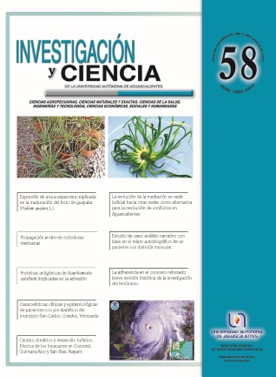Proteínas antigénicas de Acanthamoeba castellanii implicadas en la adhesión
DOI:
https://doi.org/10.33064/iycuaa2013583991Palabras clave:
Acanthamoeba castellanii, proteínas antigénicas, adhesiónResumen
Acanthamoeba castellanii es un patógeno oportunista causante de infecciones como queratitis amebiana, encefalitis granulomatosa
amebiana crónica e infecciones en la piel. En la actualidad, la acantamoebiosis es un problema en cuyo tratamiento se utilizan fármacos poco selectivos y tóxicos. La capacidad de adherencia de A. castellanii a tejidos de las células del hospedero es esencial para el desarrollo de la infección. En este trabajo se analizan las proteínas antigénicas y su papel en la adhesión del parásito a las células. Los resultados muestran mayoritariamente ocho proteínas antigénicas de Mr ≤ 180, 174, 124, 113, 84, 49, 43 y 40kDa,
localizadas en la superficie del trofozoíto. Además, los resultados de la interacción parásito huésped aplicando los anticuerpos policlonales indican una disminución de la adhesión (90%) de los trofozoítos a la célula huésped.
Descargas
Citas
• CHANG, S., Small, free-living amebas: cultivation, quantitation, identification, classification, pathogenesis, and resistance. Current Topics on Comparative Pathobiology., 1: 201-254, 1971.
• COONS, A., LEDUC, E., CONNOLLY, J., Studies on antibody production: a method for the histochemical demonstration of specific antibody and its application to a study of the hyperimmune rabbit. The Journal of Experimental Medicine, 102: 49-60, 1955.
• GARATE, M., CUBILLOS, I., MARCHANT, J., PANJWANI, N., Biochemical characterization and functional studies of Acanthamoeba mannose-binding protein. Journal: Infection and Immunity, 73: 5775-5781, 2005.
• HADAS, E., MAZUR., T., Proteolytic enzymes of pathogenic and non-pathogenic strains of Acanthamoeba spp. Tropical Medicine And Parasitology, 44: 197-200, 1993.
• HAUCK, C., Cell adhesion receptors–signaling capacity and exploitation by bacterial pathogens. Medical Microbiology and Immunology, 191: 55-62, 2002.
• KENNETT, M. J., HOOK, R. R., FRANKLIN, C. L., RILEY, L. K., Acanthamoeba castellanii: characterization of an adhesin molecule. Experimental Parasitology, 92: 161-169, 1999.
• KERR, J., Cell adhesion molecules in the pathogenesis of and host defense against microbial infection. Journalof Clinical Pathology, 52: 220-230, 1999.
• LEHER, H., ALIZADEH, H., TAYLOR, W., SHEA, A., SILVANY, R., VAN KLINK, F., JAGER, M., NIEDERKORN, J., Role of mucosal IgA in the resistance to Acanthamoeba keratitis. Investigative Ophthalmology and Visual Science, 39: 2666-2673, 1998.
• MARCIANO-CABRAL, F., CABRAL, G. A., Acanthamoeba spp. as agents of disease in humans. Clinical Microbiology Reviews, 16: 273-307, 2003.
• MATIN, A., RYOUL JEONG, S., STINS, M., KHAN, N. A., Effects of human serum on Balamuthia mandrillaris interactions with human brain microvascular endothelial cells. Journal of Medical Microbiology, 56: 30-35, 2007.
• NORIEGA, L., SOSA, A., SABANERO, L., ÁVILA, M., Influence of pulsed magnetic fields on the morphology of bone cells in early stage of growth. Micron, 42: 600-607, 2011.
• ROCHA-AZEVEDO, B., JAMERSON, M., CABRAL, G., SILVA-FILHO, F., MARCIANO-CABRAL, F., Acanthamoeba interaction with extracellular matrix glycoproteins: biological and biochemical characterization and role in cytotoxicity and invasiveness. Journal of Eukaryotic Microbiology, 56: 270-278, 2009.
• SIDDIQUI, R., KHAN, N. A., Biology and pathogenesis of Acanthamoeba. Parasites & Vectors, 5: 6, 2012.
• TOWBIN, H., STAEHELIN, T., GORDON, J., Electrophoretic transfer of proteins from polyacrilamid gels to nitrocellulose sheets: procedure and some applications. Proceedings of The National Academy Of Sciences, 76: 4350-4354, 1979.
• VISVESVARA, G., MOURA, H., SCHUSTER, F., Pathogenic and opportunistic free-living amoebae: Acanthamoeba spp., Balamuthia andrillaris, Naegleria fowleri, and Sappinia diploidea. FEMS Immunology & Medical Microbiology, 50: 1-26, 200
Descargas
Publicado
Cómo citar
Licencia
Derechos de autor 2013 José Alberto Juárez Rodríguez, Gloria Barbosa Sabanero, José de Jesús Serrano Luna, Lérida Liss Flores Villavicencio, Mineko Shibayama Salas, Myrna Sabanero López

Esta obra está bajo una licencia internacional Creative Commons Atribución-NoComercial-CompartirIgual 4.0.
Las obras publicadas en versión electrónica de la revista están bajo la licencia Creative Commons Atribución-NoComercial-CompartirIgual 4.0 Internacional (CC BY-NC-SA 4.0)









